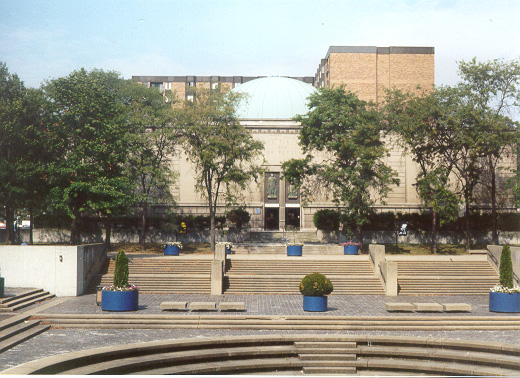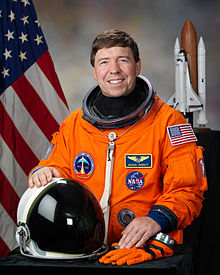
 Photographs of two historic buildings, both constructed of Indiana limestone, in the City of Pittsburgh. The photograph on the left shows Pittsburgh's original Buhl Planetarium and Institute of Popular Science in the Allegheny Center section of the North Side, which was dedicated 1939 October 24 (Photo Source: Friends of the Zeiss; Photographer: Lynne S. Walsh). The photograph on the right shows Schenley High School in the Schenley Farms section of the Oakland neighborhood, which opened 1916 October 2 (Photo Source: Wikipedia.org ).
Photographs of two historic buildings, both constructed of Indiana limestone, in the City of Pittsburgh. The photograph on the left shows Pittsburgh's original Buhl Planetarium and Institute of Popular Science in the Allegheny Center section of the North Side, which was dedicated 1939 October 24 (Photo Source: Friends of the Zeiss; Photographer: Lynne S. Walsh). The photograph on the right shows Schenley High School in the Schenley Farms section of the Oakland neighborhood, which opened 1916 October 2 (Photo Source: Wikipedia.org ).
Last week, the weekly
Pittsburgh City Paper published a news article on the efforts of graduates of Pittsburgh's Schenley High School to stop the Pittsburgh Public Schools from selling the historic building, so that the building can be converted into 178 luxury apartments. The Schenley alumni believe that the building is still usable as, and should remain as, a school:
Brown, AmyJo. "Most Likely to Succeed? Facing an uphill battle, a group of Schenley grads want to keep the building full of students."
Pittsburgh City Paper 2013 Feb. 13.
Link >>>
http://www.pghcitypaper.com/pittsburgh/most-likely-to-succeed-facing-an-uphill-battle-a-group-of-schenley-grads-want-to-keep-the-building-full-of-students/Content?oid=1618064
In this week's issue of the
Pittsburgh City Paper, Friends of the Zeiss Project Director Glenn A. Walsh responds with a Letter-to-the-Editor published in the "Incoming" column on page 6, comparing these efforts of the Schenley High School alumni with similar efforts, more than a decade ago, of former employees and volunteers of Pittsburgh's original Buhl Planetarium and Institute of Popular Science to maintain the educational capabilities of historic Buhl Planetarium equipment and artifacts in the historic Buhl Planetarium building, currently used for educational purposes by the Children's Museum of Pittsburgh.
INCOMING
Letter to the Editor
Editor,
Deja vu is what I felt when I read your Feb. 13 article
on the alumni efforts to maintain the historic Schenley High School as a
school. Twelve years ago,
City Paper ran a great story on our similar
efforts to maintain the historic Buhl Planetarium equipment and
artifacts as teaching tools in the historic building, now used by the
Children's Museum.
Although the Zeiss II Planetarium Projector is
now on display at The Carnegie Science Center, it no longer does what
is does best: a second-to-none, realistic depiction of the planets and
stars in the night sky. The 10-inch Siderostat-type Refractor Telescope
and most other artifacts remain in storage, benefiting no one.
Regrettably,
I fear the final result from the efforts of the Schenley alumni will
mirror the result of our efforts to preserve the functionality of the
historic Buhl Planetarium apparatus.
-- Glenn A. Walsh, project director,
Friends of the Zeiss
Mount Lebanon
Sources:
Pitttsburgh City Paper, Friends of the Zeiss.
More on the History of --
Pittsburgh's original Buhl Planetarium and Institute of Popular Science:
Link >>> http://www.planetarium.cc/
Historic Zeiss II Planetarium Projector of The Buhl Planetarium and Institute of Popular Science:
Link >>> http://buhlplanetarium3.tripod.com/BuhlZeissII.htm
Historic 10-inch Siderostat-type Refractor Telescope of The Buhl Planetarium and Institute of Popular Science:
Link >>> http://spacewatchtower.blogspot.com/2011/11/70th-anniversary-buhl-planetarium.html
Historic Schenley High School:
Link >>> http://en.wikipedia.org/wiki/Schenley_High_School
Zlatos, Bill. "Pittsburgh school board approves sale of former Schenley High School."
Pittsburgh Tribune-Review On-Line 2013 Feb. 27.
Link >>> http://triblive.com/news/adminpage/3528542-74/schenley-board-voted#axzz2MEvd4bYX
Chute, Eleanor. "Schenley High School building in Oakland sold to developer."
Pittsburgh Post-Gazette 2013 Feb. 28.
Link >>> http://www.post-gazette.com/stories/news/education/schenley-high-school-building-in-oakland-sold-to-developer-677221/
gaw
Glenn A. Walsh, Project Director,
Friends of the Zeiss <
http://friendsofthezeiss.org
>
Electronic Mail - <
gawalsh@planetarium.cc
>
About the Author: <
http://buhlplanetarium.tripod.com/#GAW >
SPACE & SCIENCE NEWS, ASTRONOMICAL CALENDAR:
<
http://buhlplanetarium.tripod.com/#news
>
Twitter: <
http://twitter.com/spacewatchtower
>
Facebook: <
http://www.facebook.com/pages/SpaceWatchtower/238017839577841?sk=wall
>
Blog: <
http://spacewatchtower.blogspot.com/
>
Author of History Web Sites on the Internet --
* Buhl Planetarium,
Pittsburgh:
<
http://www.planetariu p.m. m.cc >
*
Adler Planetarium, Chicago:
<
http://adlerplanetarium.tripod.com
>
* Astronomer, Educator, Optician John A. Brashear:
<
http://johnbrashear.tripod.com >
*
Andrew Carnegie & Carnegie Libraries:
<
http://www.andrewcarnegie.cc >
* Civil War Museum of Andrew Carnegie Free Library:
<
http://garespypost.tripod.com >
*
Duquesne Incline
cable-car railway, Pittsburgh:
<
http://inclinedplane.tripod.com
>
* Public Transit:
<
http://andrewcarnegie2.tripod.com/transit
>

 Two giant swaths of radiation, known as the Van
Two giant swaths of radiation, known as the Van












